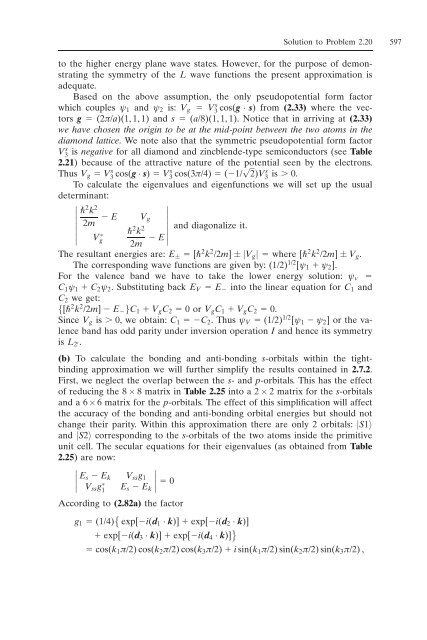10. Appendix
Create successful ePaper yourself
Turn your PDF publications into a flip-book with our unique Google optimized e-Paper software.
Solution to Problem 2.20 597<br />
to the higher energy plane wave states. However, for the purpose of demonstrating<br />
the symmetry of the L wave functions the present approximation is<br />
adequate.<br />
Based on the above assumption, the only pseudopotential form factor<br />
which couples „1 and „2 is: Vg V s 3<br />
cos(g · s) from (2.33) where the vec-<br />
tors g (2apple/a)(1, 1, 1) and s (a/8)(1, 1, 1). Notice that in arriving at (2.33)<br />
we have chosen the origin to be at the mid-point between the two atoms in the<br />
diamond lattice. We note also that the symmetric pseudopotential form factor<br />
Vs 3 is negative for all diamond and zincblende-type semiconductors (see Table<br />
2.21) because of the attractive nature of the potential seen by the electrons.<br />
Thus Vg Vs 3 cos(g · s) Vs 3 cos(3apple/4) (1/√2)Vs 3 is 0.<br />
To calculate the eigenvalues and eigenfunctions we will set up the usual<br />
determinant:<br />
<br />
<br />
<br />
<br />
<br />
<br />
<br />
<br />
2k2 E Vg<br />
2m<br />
V∗ <br />
g<br />
2k2 <br />
<br />
<br />
<br />
and diagonalize it.<br />
<br />
E <br />
2m<br />
The resultant energies are: E± [2k2 /2m] ±|Vg| where [2k2 /2m] ± Vg.<br />
The corresponding wave functions are given by: (1/2) 1/2 [„1 „2].<br />
For the valence band we have to take the lower energy solution: „v <br />
C1„1 C2„2. Substituting back EV E into the linear equation for C1 and<br />
C2 we get:<br />
{[2k2 /2m] E}C1 VgC2 0orVgC1 VgC2 0.<br />
Since Vg is 0, we obtain: C1 C2. Thus „V (1/2) 1/2 [„1 „2] or the valence<br />
band has odd parity under inversion operation I and hence its symmetry<br />
is L2 ′.<br />
(b) To calculate the bonding and anti-bonding s-orbitals within the tightbinding<br />
approximation we will further simplify the results contained in 2.7.2.<br />
First, we neglect the overlap between the s- and p-orbitals. This has the effect<br />
of reducing the 8 × 8 matrix in Table 2.25 into a 2 × 2 matrix for the s-orbitals<br />
and a 6×6 matrix for the p-orbitals. The effect of this simplification will affect<br />
the accuracy of the bonding and anti-bonding orbital energies but should not<br />
change their parity. Within this approximation there are only 2 orbitals: |S1〉<br />
and |S2〉 corresponding to the s-orbitals of the two atoms inside the primitive<br />
unit cell. The secular equations for their eigenvalues (as obtained from Table<br />
2.25) are now:<br />
<br />
<br />
<br />
Es<br />
<br />
Ek Vssg1<br />
<br />
<br />
0<br />
Vssg ∗ 1<br />
Es Ek<br />
According to (2.82a) the factor<br />
g1 (1/4) exp[i(d1 · k)] exp[i(d2 · k)]<br />
exp[i(d3 · k)] exp[i(d4 · k)] <br />
cos(k1apple/2) cos(k2apple/2) cos(k3apple/2) i sin(k1apple/2) sin(k2apple/2) sin(k3apple/2) ,










